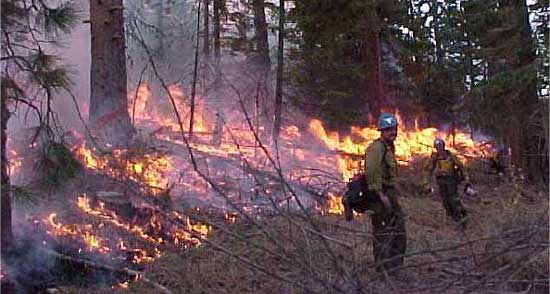| Natural Notes |
National Park Service U.S. Department of the Interior 2002-2003 North Cascades National Park Service Complex |

|
Prescribing flames for preservation & protection
|
Fire plays a vital role in maintaining and restoring natural ecosystems in North Cascades National Park. Fire in the wrong place, however, can result in the loss of life or dwellings and can alter natural vegetation types. In order to allow this important and powerful disturbance agent to continue diversifying vegetation, while keeping unwanted fires from resulting in tragic losses, the fire management team carefully weighs potential benefits and losses in each fire management decision.
The park's fire team is comprised of personnel with expertise in fire ecology, suppression strategies, prescribed fire, silviculture planning and program management. Fire management personnel work closely with other park resource specialists and the public to develop and implement management and operational plans. The fire team cooperates with neighboring agencies to provide assistance in meeting program goals. All options for fire suppression are considered: lightning fire management, prescribed fire for thinning small-diameter trees, community protection and restoring fire-dependent ecosystems. One hundred and ninety-three acres of ponderosa pine and Douglas fir have been burned and 40 acres have been thinned to reduce the fire threat to Stehekin. Additional treatment is planned for the area and in Hozomeen. All thining treatments are closely monitored by fire personnel. Through long-term monitoring, treatment effects are recorded and used to measure progress toward meeting fire program goals. The glaciers are a vital component of the North Cascades ecosystem. They influence soil development, vegetation distribution and flooding and are unique indicators of climatic change. Glaciers are formed when more snow accumulates in winter than melts or evaporates during the following summer. The immense weight of this continuous buildup causes the snow to compact into ice, which then slowly moves downhill. As glaciers move, they gouge and scrape the landscape, continuously redefining it. Mountains may appear to be in suspended animation, but like everything else, they are in a continuous state of change.
Practicing the three R's Restoration of the Goodell Creek Gravel Pit began in October 2001 along part of the east side of Goodell Creek. The National Park Service is implementing ecological restoration on approximately 0.6 acres of the 6-acre former gravel pit near Newhalem. The park, with funds from the Washington State Department of Transportation, will plant the area with a variety of native trees and seeds. The spectacular 2001 fall salmon run in Goodell Creek reflects the importance of this stream. Restoration of the riparian zone will provide a continuous wildlife corridor along the east bank of the creek from the Skagit River to its headwaters, and will improve salmon habitat by creating a buffer zone along the creek.
The 0.6 acreage includes the gravel pit segment located closest to Goodell Creek where drain rock and sand were stockpiled. Without plant cover this area could erode and be readily invaded by alien plants, such as Japanese knotweed. In another restoration effort the park needs visitor help. Rehabilitation efforts are taking place in spots along Ross Lake. The NPS recently built log cribbing and rock walls, and planted native species in order to stabilize erosion. Unfortunately for the new plants, the Ross Lake area is a relatively dry part of the North Cascades National Park Service Complex. These new plants thrive better if watered in the first two years after planting. You can help by using the watering cans provided along the edges of revegetation sites. For more information on these projects pick up the Ross Lake Rehabilitation or North Cascades Revegetation brochures at the Visitor Center or other NPS office. |
| <<< Previous | > Cover Page < | Next >>> |

